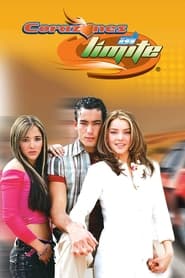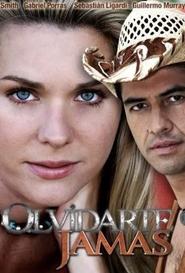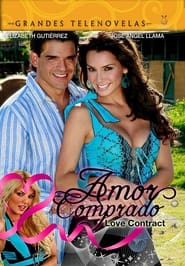Univision TV Series - Page 3
-
Imperio De Mentiras
2020
star 7.4Elisa Cantú never imagined that, upon returning to Mexico from New York, where she resides, she would encounter an unexpected tragedy that changes her life. The night Elisa would celebrate her birthday, fate leads her to meet Leonardo Velasco, a policeman in love with Julia, a teacher, to whom he was to marry. At the end of the evening, Leonardo receives an emergency call, in which the discovery of two bodies is reported, one of them is that of his fiancée, who lies next to the body of Augusto Cantú, millionaire businessman and father of Elisa. Elisa and Leonardo will come together to search for the truth of what happened. -
The Talisman
2012
The Talisman
2012
El Talismán is a telenovela co-produced by Venevision and Univision Studios, starring Blanca Soto and Rafael Novoa as the main protagonists, and Aarón Díaz, Lola Ponce, and Marcela Mar as the main antagonists. Univision had announced that El Talismán would air on the network as part of the 2011–2012 programming schedule, and was confirmed to air in 2012 on November 11, 2011. Though 120 episodes were planned to be produced, the episode count was reduced to a total of 98 due to low ratings. From January 30 to February 3, 2012, Univision aired El Talismán at 8pm central, replacing one hour of Una familia con suerte, and later at 9pm central from February 6 to March 9, 2012. Though El Talismán was seen by 5 million viewers during its premiere day, viewership declined overtime during its prime time airings. As a result, Univision aired El Talismán at 1pm central from March 12 to June 15, 2012. -
Hearts to the Limit
2004
star 6.5Corazones al límite is a Mexican telenovela about a teenage girl named Diana who was emotionally neglected from her parents, and felt unwanted. After being expelled from her boarding school in Switzerland, Diana goes back to live with her parents. -
La Herencia
2022
star 7.6In an avocado farm called "Santa Catalina", Severiano del Monte and his five adopted sons live. Severiano passes away and the lives of his sons change on the day of the reading of the will, with the unexpected appearance of Sara, their sister, whom they did not know existed. -
Olvidarte Jamás
2006
star 2At that time her name was Luisa, she was a humble and naive peasant who worked with her grandmother on the ranch of the powerful Montero. Also at that time she was outraged by Gonzalo, the son of the ruthless hacienda owner, Don Gregorio. She became pregnant, Gladis, Gonzalo's wife, had the girl be beaten to make her lose the baby, which she achieved. Gregorio had the little house where he lived with his grandmother burned, the latter dying in the horrible fire. She was expelled like a dog from the ranch, she left town like a common criminal, but the years have passed, Luisa who now calls herself Victoria has returned to town with an adopted daughter and turned into a sophisticated, rich and powerful woman, with a single goal in mind: revenge on everyone who hurt him so much. -
Passion
2007
star 2Pasión is the telenovela that began transmissions on September 17, 2007, in Mexico; Canal de las Estrellas. The novela is a production of Carla Estrada and the stars are Susana González, Fernando Colunga, Sebastián Rulli, and Daniela Castro. -
Inocente de Ti
2004
star 6.7Inocente de Ti is a Miami-based 130 episode telenovela that first aired on the Univision network in 2005. It features Camila Sodi, Valentino Lanús, and Helena Rojo. -
Amor Comprado
2008
Amor Comprado
2008
Amor Comprado is a Miami, Florida-made telenovela that was produced by Venevisión International for Univision. It is loosely inspired by TV Azteca's Catalina y Sebastian, written by the same writer of this project. The series stars Elizabeth Gutiérrez and José Ángel Llamas as the protagonists while Patricia Álvarez, Marjorie de Sousa and Zully Montero star as the main villains. Filmed and set in Miami, Florida, USA, the show replaced Nunca Te Diré Adiós at 1PM/12C on Univision. The telenovela also aired in Ecuador at 10:15pm on TC Televisión, on Canal 9 in Valencia, Spain and on Telemetro in Panama. It began airing in Venezuela on October 29, 2008, via Venevisión Plus at 10:00pm with repeats Monday to Saturday at 1:00pm. It was broadcast in United States, Ecuador, Spain, Panama, Chile and Venezuela. -
El amor invencible
2023
star 7.3After losing all her loved ones fifteen years ago and believing her babies were killed at the hands of the father of her first love, Leona Bravo embarks on a journey of justice against all those who hurt her. In this process, Leona discovers that her children are actually alive and is reunited with an old friend with whom she finds true love. As a result, she will be torn between her desire for justice and rebuilding her bond with her two children, as well as regaining her faith in love. -
The Three Sides of Ana
2016
star 7.1Over a road trip, triplets Ana Laura, Ana Leticia, and Ana Lucía, along with their parents, suffer a dramatic accident crashing by the side of a river. The consequences of this event are catastrophic: Both parents die, Ana Laura loses one leg, and Ana Lucía, unconscious, is dragged by the river’s flow. Only Ana Leticia, who actually caused the accident, emerges unscathed. Soledad, a woman who was seriously hurt after her daughter’s death, helps Ana Lucía, whom she finds agonizing. Although Soledad discovers who the girl is, she takes advantage of her memory loss regarding the accident and her family and decides to keep her, making her believe she is her mother. Despite everyone declares Ana Lucía is death, Ernestina, the triplets' grandmother, and Ramiro, their uncle, don’t give up and do everything they can to find Ana Lucía. But years go by, the same as their wishful -
Latin Grammy Awards
2000
star 7A Latin Grammy Award is an award by The Latin Recording Academy to recognize outstanding achievement in the Latin music industry. The Latin Grammy honors works produced anywhere around the world that were recorded in either Spanish or Portuguese and is awarded in the United States. -
Secrets at the Hotel
2016
star 7The story of Secrets at the Hotel begins in 1908. Julio Olmedo and Isabel Alarcón travel on the same train to the Gran Hotel, property of the Alarcón family. Both of them ignore that their lives will take a new twist in that place, produced by love, treason, and the secrets hidden there. -
Metástasis
2014
star 7.1A Colombian remake of the U.S. TV show Breaking Bad. After he is diagnosed with cancer, Walter Blanco teams up with José Miguel Rosas in order to sell crystal meth. -
Amorcito Corazón
2011
star 6.5Amorcito Corazón is a Mexican telenovela produced by Televisa by Lucero Suarez. Rehabilitation of the Venezuelan RCTV telenovela Trapos Intimos. It stars Elizabeth Álvarez, Diego Olivera, Africa Zavala and Daniel Arenas, involving Fabiola Campomanes, Gerardo Murguia and Macaria as the main villains and stellar performances by the leading lady Mariana Karr, and Grettell Valdez. Canal de las Estrellas broadcast Amorcito Corazón from August 29, 2011, to June 10, 2012, with Cachito de Cielo replacing it. Univision confirmed an afternoon airing of Amorcito Corazón, and is currently seen weekday afternoons at 2pm central. Previously, Univision broadcast it at 3pm, replacing Dos Hogares from May 30 to June 15, 2012.



















